Longtime friend and crime fiction author Jim Winter is interviewing me on his blog today – please stop in and say hi!



Longtime friend and crime fiction author Jim Winter is interviewing me on his blog today – please stop in and say hi!

Ever since I can remember, Labor Day has always included the Holiday at Home parade and festival. I grew up in Kettering, the south Dayton suburb where it’s hosted, and remember setting out lawn chairs to watch the parade a few times when I was little. Other times, especially when it was really hot or rainy, we watched it on TV.

Dayton History had a nice showing in this year's parade
So I knew the event had been around since at least the early 70’s. Curious, I looked up the official website to find out when it all really began. Initially called Kettering Day, the first event was held in 1959 and hosted by the Kettering YMCA for a membership drive. Community leaders got involved and encouraged the Y to add a parade and program of events, and it was so well-attended it was a foregone conclusion it would become an annual event. Eventually, a contest was held to find a new name, and community leadership chose Holiday at Home because it encourages residents to stay home and have fun around here, rather than travel. Although it’s centered in Kettering, all are welcome, and many other south-side communities are involved.

The Millennium Falcon was the coolest float in this year's Holiday at Home Parade
Public events begin the day before Labor Day, when the festival begins. It includes an arts and crafts show with vendors all around, food, and live entertainment.
The parade is the capstone event, and begins around 10 AM on Labor Day. The Holiday at Home parade is the largest in the Miami Valley. Area residents stake out parade-watching spots as early as the day before by setting out lawn chairs (which amazingly, as far as I know, don’t get stolen). The parade attracts an audience of over 10,000 people, and that’s not counting those who watch on TV. School and community marching bands, veterans’ organizations, civic groups, nonprofit organizations, and local businesses participate, with floats, performances, or vehicles in the parade. My husband’s AMVETS chapter’s riders’ group rides their motorcycles in the parade.
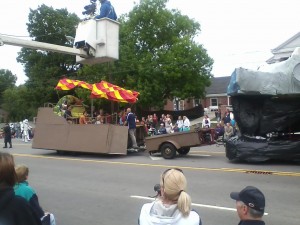
What's Star Wars without the Cantina? Jabba the Hut's in residence, enjoying a live jazz band from Fairmont H.S.
After the parade, which ends around noon, the festival goes on, with more food, arts and crafts, and entertainment. There’s also a fantastic classic car show, which is by invitation only and includes some sweet rides you don’t always see at the cruise-ins throughout the summer.
All in all, it’s a good time, and sure beats driving through Labor Day traffic.
If you live in the Dayton area, do you go to the Holiday at Home festival? Or watch the parade on TV? If you’re from elsewhere, what do you do on Labor Day weekend – does your community give you a reason to stay home?
More at the My Town Monday blog

My time management plans have been a bit challenging lately. The main reason for this is that I have several ongoing tasks on my plate that each need more time than the allotted hour each evening. Some have fallen off the schedule, except sporadically – email and social media, for example. In some cases, this was unexpected. An upgrade to my accounting software that should have been easy, ended up taking up a whole evening, ending with a lengthy tech support phone call (normally, a last resort for me). All ended up well, as the technician was actually able to help and we finally determined that the download sites I’d tried getting the software from, were both dishing up bad files. Still, that’s three hours I can’t get back.
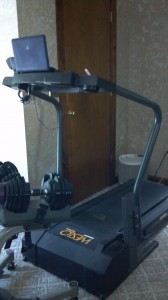
Treadmill + good stuff to read on my netbook + DUH = Success!
One thing that amazingly hasn’t fallen off the schedule is my physical activity, which for the most part amounts to a thirty-minute interval workout on the treadmill. I’ll be honest here: I hate exercising. I like walking in and of itself, but I don’t like to sweat (which the interval workouts certainly do), I get easily bored, and I get stressed thinking of all the other stuff that needs to be done, that I’d much rather be doing.
So how have I kept it up?
Two things, actually. The first is something I learned several years ago in psychologist/author Margie Lawson‘s wonderful Defeat Self-defeating Behaviors online workshop: The DUH principle.
The DUH principle is pretty simple, and therin lies its beauty. Its three facets are:
The other thing that’s helped me is Make it Fun if at all possible. With a little help from my netbook, the Kindle for PC app, and tons of great books, my exercise time doubles as reading time – something all writers should do anyway. So knowing I’ve got a good book to read just waiting on my netbook is a great incentive, and helps me get past the I-don’t-feel-like-its. It really makes that half hour zip by. Years ago, I tried reading print books on the treadmill. Didn’t work. My treadmill has a book slot on its control panel, but the panel is way too high for me, and it’s too low a slant. It was also a pain to turn pages. The netbook holds the book at the perfect angle, and turning the page is just a tap on the page-down button.
Got any good tips on getting an un-fun task done? Please share! And if you’re having trouble, try the DUH principle – and see if you can make that drudgery fun!

The other day, my husband, daughter and I rode our Harleys up to visit some friends in Columbus, and had the chance to partake in some tasty history there at Schmidt’s Sausage Haus. Located in historic German Village, Schmidt’s is a well-known foodie landmark, thanks in part to the Travel Channel’s Man vs. Food. This is what led us there as well.
We arrived at Schmidt’s around 2PM, hoping such an off time would result in an easy in. We had a half hour wait for our party of five, so we went and checked out Schmidt’s Fudge Shop, across the street, where an integrated paging system would alert us to our table being ready. Once we were seated a half hour later, to the minute, we learned that a half hour wait time at any time on a Saturday was short. Our server told us the typical Saturday wait time, even at 2pm, was two hours!
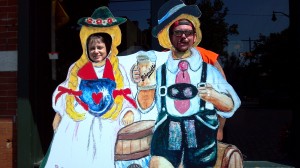
DH and I pose in the photo frame stand outside the restaurant
However, once we were seated, the wait time was almost nothing. My husband, daughter, and both our friends chose the Autobahn Buffet, which featured four types of sausage, sauerkraut, chicken, potato salad, and tons of choices for traditional salads. The latter was especially appreciated by one of our friends who, in a twist of irony, is vegan. She’d insisted it was no problem to go to Schmidt’s, when we asked, as she’d figured she could get a side salad then something at home later, if need be. No worries – she found plenty to fill up on in the salad bar! Schmidt’s also has Mountain Dew, which is always a plus for me. 🙂
To my surprise, my meal arrived just a few minutes after the others had loaded up their plates at the buffet. I had the Hoffbrau Schnitzel, which was pork tenderloin with mushroom gravy. Yum! But the best part was dessert – our group minus my vegan friend split two of Schmidt’s legendary half-pound cream puffs, which were featured in coconut that day – my favorite! There were four impending food comas afterward, which we managed to shake off by going bowling. Good weather, good ride, good time, good friends, good food. Can’t ask for a better Saturday!
There are a couple other restaurants in Columbus that have been featured on Man vs. Food, which is one of my family’s favorite shows, so we plan to visit those in the future. Dayton has yet to be featured on a show like this. Has your hometown had any local eateries featured on a national TV show, and if so, have you been there?

Note: I realize this won’t apply to most people, but then again, it might be applicable to more than one would think. So in case it might help someone who wouldn’t otherwise be aware, I’m sharing how I got Microsoft Office, legally, on the cheap.
After my diatribe about Microsoft Word a few weeks ago, I ended up buying it. As noted in that blog post, OpenOffice is a great alternative to Office, but not a perfect one. So when I got an email at work saying I could purchase Office for my own use at home, for $9.95, I checked it out right away.
 Of course, skeptic that I am, I thought it sounded too good to be true. But the email was from an official U.S. Air Force channel, and the link went to microsoft.com, so I clicked.
Of course, skeptic that I am, I thought it sounded too good to be true. But the email was from an official U.S. Air Force channel, and the link went to microsoft.com, so I clicked.
The offer comes from the Microsoft Home Use Program, which the U.S. Air Force participates in. Many other government agencies do too, as well as many private companies. I had no idea this was available to me until I saw it in a newsletter I get at work. Best of all, it’s available to on-site contractors as well as government employees.
From what I understand based on the information at the Microsoft Home Use Program, it looks like any company that participates in Microsoft’s Software Assurance Program and chooses to participate, can. The link above goes to a U.S.-specific site, but they may have programs in place for other countries, too. Some companies that are eligible to participate choose not to, in many cases due to misinformation.
Of course, there are a lot of terms and conditions. The main one to note is that, if you leave your eligible job, you’re supposed to discontinue using the software. It doesn’t have to be used just for work purposes, and the only information you need to supply is your work email (for the eligible company/organization), and the basics like your address.
I figured for $10*, why not? As I work on formatting my book for print, I’m finding a lot of details easier to implement in Word than OpenOffice, like sections, for instance. For most other word processing, I still use OpenOffice, because I prefer its menu-based interface. But if you work for a large company or government organization, it might be worth checking with your IT department to see if they offer this program!
*The $9.95 price is for a download. You can get the product on CDs, but it’s an additional charge of around $12 or so.

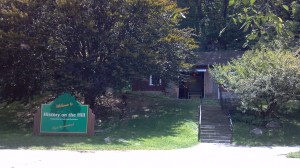
History on the Hill
They’ve been busy adding new features, exhibits, and fun things to see at Dayton’s Carillon Historical Park these past couple of years. Just this past weekend, the park opened several new exhibits, including the Carousel of Innovation. Last summer, they opened the History on the Hill exhibit in the old carriage house, and created a series of trails and steps on the bluffs behind the building. History on the Hill begins here.
Overlooking the Great Miami River, the bluffs were created as part of glacial recession from the last ice age. The Dayton area sits on the terminal moraine, which is the farthest point south reached by glaciers during the last ice age. The exhibits inside the building provide some drawings and details about this, as well as more recent history. For example, the park site belonged to NCR (The National Cash Register Company) prior to the park’s construction, and the area near the bluffs was used as a target shooting range.
 The trail winds up the hill and around the parking lot, close to South Dixie Drive. It then leads past the neighboring Calvary Cemetery, to a picnic shelter of sorts called an Andirondack hut. In the early 20th century, the bluffs also housed a sanitarium, where smallpox patients were quarantined. The remants of a floor here might have been part of this building, I’m not sure.
The trail winds up the hill and around the parking lot, close to South Dixie Drive. It then leads past the neighboring Calvary Cemetery, to a picnic shelter of sorts called an Andirondack hut. In the early 20th century, the bluffs also housed a sanitarium, where smallpox patients were quarantined. The remants of a floor here might have been part of this building, I’m not sure.
The trails are a neat little walk (I’m guessing the entire trail is maybe a mile, probably less). If you go, make sure you wear good shoes – there are several steep areas, and one of the staircases isn’t completed. For these reasons, the trails themselves aren’t suitable for people with mobility problems, although there is a ramp up to the building.
Near the end of the trail on the west side of the exhibit building is a long, corrugated, black plastic pipe of about 30 inches in diameter. It goes down a steep slope alongside one of the staircases for probably a couple dozen yards or so. The park map calls this the Glacial Adventure. It’s not suitable to slide down, so I’m not sure of the reasoning behind that name. There are also several areas of the trail that are obviously not yet complete, as they’re blocked off by caution tape.
Despite its not-quite-completeness in a few places, History on the Hill is a fun little diversion and is certainly worth a look next time you visit Carillon Park.
If you live in the Dayton area, have you check out History on the Hill yet? If not, do you have something similar in your area?
More at the My Town Monday blog

I’m not talking about story details; I’m talking about little, visual details – graphics, chapter headings, fonts.
I’ve been thinking about these details a lot because now that Time’s Enemy is out in digital format, I’m starting to work on the print version.
There are a lot of extra considerations to make when planning a print version. There’s a lot more to creating a print cover, but there are also many decisions for the book’s interior. Foremost is which font to use for the body text? And yes, there is life after Times New Roman. I considered Garamond, Palatino, and Book Antiqua, but finally settled on Caxton. It’s a really pretty font, is sort of a combination of old style with a modern flair, and gives the page a nice, even “color.” The main thing you’re looking for is readability, and for body text that’s going to be printed, that usually means a serif typeface. For those unfamiliar with graphic arts terms, “serif” means the typeface has little brackets on the ends of the letter strokes. All the fonts I’ve mentioned above are serif typefaces. Sans-serif fonts (i.e., fonts without serifs) include Arial, Verdana, and Trebuchet, and are better suited for headings or on-screen reading, such as web pages.

The print version of Time's Enemy is set in Caxton, with right-justified chapter headings
The next consideration is display type, or what font to use in chapter headings and on the book’s title page. This is a good place for decorative fonts, and book designers can have a lot of fun with these. For my print book, I’m leaning toward Belwe, which is the same display font as the title on the book cover. Chapter headings are typically centered, but not always, and I liked the way my chapter headings look right-aligned, with a thin border beneath. Some books spell out “Chapter One,” while others just say “One” or even just have the numeral: 1. And finally, some feature small graphics, or glyphs, beside, above or below the chapter heading.
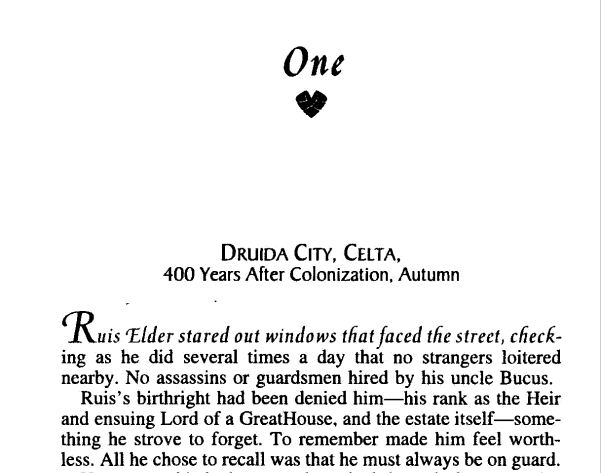
Robin D. Owens' Heart Thief has a lovely little glyph under the chapter heading, and the first line in italics. Threshhold, by Sara Douglass, featurs drop caps and a nice glyph above the chapter headings
Another thing to consider is how to treat the initial characters and/or line of text in a chapter or scene. Drop caps? First line in italics? First line in small caps? I’ve seen all of these done by big publishers, and it’s a nice way to set off the beginning of a chapter or scene. I didn’t care for the way drop caps looked in my book, and small caps wasn’t as uniform in appearance as I’d like, so I went with italics. Of course, there are other considerations like page size, margins, headers, and so on, but those are subjects for anotherblog (or several).
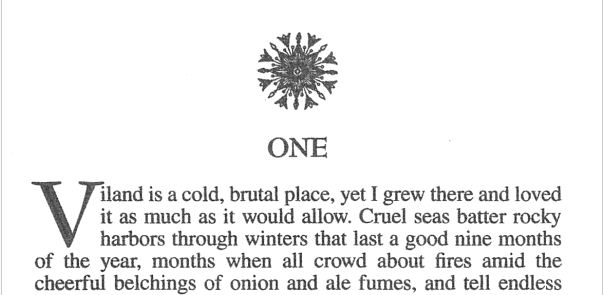
Threshhold, by Sara Douglass, featurs drop caps and a nice glyph above the chapter headings
Then there are glyphs. I loooooooove glyphs – those little, deccorative images that sometimes display with chapter headings, or between scenes. I didn’t think they’d be practical to do in eBooks, but then happened upon a wonderful book with awesome little glyphs between scenes, so I knew I had to have them in my book, too! What’s really cool is when the image directly relates to the story, as is the case in both of Cate Rowan’s books, as well as mine.
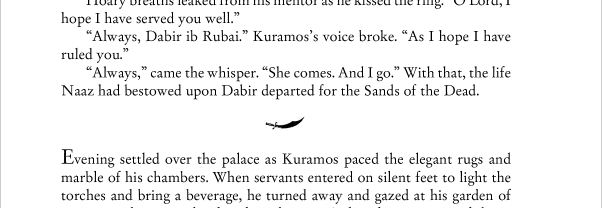
The scimitar is an important prop in Cate Rowan's Kismet's Kiss
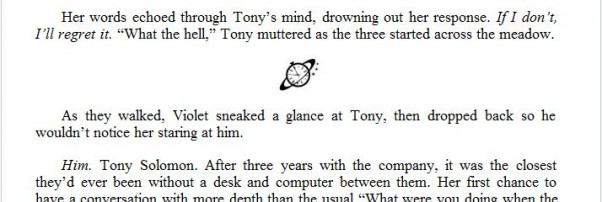
A tiny Saturn Society logo separates the scenes in my books
If a book is typeset in an unusual font, or has glyphs separating scenes or with chapter headings, I notice. I figure this is due to my background in graphic design, but maybe not – do you notice little details like this? Got any examples to share of particularly attractive chapter headings, or scene separation glyphs?
Oh, and by the way, these are all awesome books! For some reason, I’m either into fantasy romance right now, or maybe those are just the kind of books that are more likely to feature these design details. Pretty pictures or not, Heart Thief, Threshhold, and Kismet’s Kiss are fantastic books. If this is your kind of story, I encourage you to check them out. And of course, I’d love for you to check out Time’s Enemy!

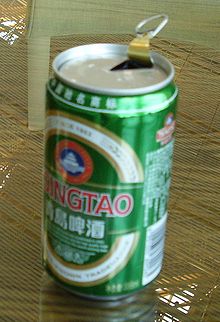 One of the fun things about writing (and reading) time travel stories is the whole fish-out-of-water aspect, especially when someone goes into the future. There is one scene in Time’s Enemy, my newly-released time-travel novel, where a character from the 1930s comes forward to modern times. When she asks for a drink and is handed a can of Mountain Dew, she’s understandably perplexed at what to do with it (and initially thinks it’s moonshine, LOL).
One of the fun things about writing (and reading) time travel stories is the whole fish-out-of-water aspect, especially when someone goes into the future. There is one scene in Time’s Enemy, my newly-released time-travel novel, where a character from the 1930s comes forward to modern times. When she asks for a drink and is handed a can of Mountain Dew, she’s understandably perplexed at what to do with it (and initially thinks it’s moonshine, LOL).
Anyone remember drinking beer or pop (“soda” for you non-Midwesterners) from a can like this? Younger folks might not, but in the sixties, seventies, and into the early eighties, this is what you got if you bought beer in a can, or got a Coke, Pepsi, etc. from a machine. Of course, I also remember pop in glass bottles – you know, where you bought a six pack at Kroger and paid a deposit of $.05 – .10 per bottle, which they returned when you took the bottles back to the store.
But back to the cans – before they were like this, they required a can opener, like is still used today to open larger cans of juice, although those are now mostly replaced by bottles. The can opener had a sharp point on it, and poked a triangle hole in the edge of the can. A second hole was needed to admit air.
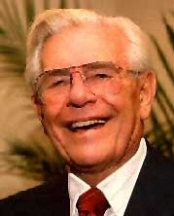
Dayton inventor Ermal Fraze
The pull tab shown on the can to the right came about in the early sixties, after Dayton tool-and-die maker Ermal Fraze went on a picnic, and forgot to bring a can opener for the drinks. According to the stories, he ended up prying cans open on a car bumper (???), then went home and devised a can with a built-in opener – the pull tab.
The pull tab was eventually superceded by the now-familiar push-in top in the eighties, but it was the pull tab that helped push cans to edge out glass bottles in popularity as a beverage container. Fraze’s legacy lives on today in the form of full-top pull tabs that are still commonly used in canned snacks like peanuts. Dayton Reliable Tool (now DRT Mfg.), the machine shop he formed in the 1940s, is also still in business in Dayton today.
Do you know of any cool little details that we take for granted today, that originated in your hometown? Please share!
More at the My Town Monday blog
Sources: http://en.wikipedia.org/wiki/Beverage_can
http://web.mit.edu/invent/iow/fraze.html
http://www.heartlandscience.org/manuf/poptop.htm
Photo of beer can via Wikipedia, public domain
Photo of Ermal Fraze via Heartlandscience.org

 One unwanted gift. One great wrong. One chance to make things right…
One unwanted gift. One great wrong. One chance to make things right…
When a freak accident leaves Tony Solomon with the ability to travel in time, he becomes an unwilling initiate in the Saturn Society, a secret society of time travelers. Wanted by the Society for a crime he hasn’t yet committed, he seeks help from Charlotte Henderson, the woman whose life he saved decades before he was born. Loyal to the Society, Charlotte faces a terrible choice-condemn the man she loves and to whom she owes her life, or deny her deepest convictions by helping him escape and risk sharing his sentence.
Time’s Enemy is available for Kindle, Nook, and a variety of ebook formats on Smashwords and other retailers. I’m also going to offer a discount coupon for Smashwords that will only be announced here, so check back soon, or better yet, subscribe!
Buy Time’s Enemy at Amazon | Barnes and Noble | Smashwords | All Romance eBooks
Print edition coming soon
 On another note, Sheri McGathy’s short story “Promises” is now available in the Kindle Store as well! Many thanks to Sheri for letting me use her story as a guinea pig to learn Kindle formatting. If you enjoy epic fantasy and are looking for a quick read, give it a try! “Promises” is also available at Barnes & Noble and Smashwords, as well as iBookstore, Kobo, and other digital retailers.
On another note, Sheri McGathy’s short story “Promises” is now available in the Kindle Store as well! Many thanks to Sheri for letting me use her story as a guinea pig to learn Kindle formatting. If you enjoy epic fantasy and are looking for a quick read, give it a try! “Promises” is also available at Barnes & Noble and Smashwords, as well as iBookstore, Kobo, and other digital retailers.

The Dayton area has always been fortunate to have a fantastic library. For two centuries, the library has been a vital part of our community.
The very first officially-recognized public library in Ohio, Dayton’s first library was started in 1805, in the home of Benjamin Van Cleve. Back then, it was a pay service. The library moved several times and was even closed and all its books sold, on at least two occasion.
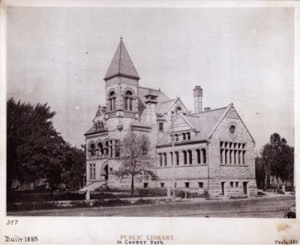 The precursor to today’s Dayton Metro Library was built on the current library’s property in 1888. This building was also home to a museum, which included natural history and Native American artifacts. The museum later became the Dayton Museum of Natural History, and eventually was renamed the Booneshoft Museum of Discovery. The museum was moved into its own location in 1955, and the library continued to serve as such until it was demolished, and the current building built, in 1961.
The precursor to today’s Dayton Metro Library was built on the current library’s property in 1888. This building was also home to a museum, which included natural history and Native American artifacts. The museum later became the Dayton Museum of Natural History, and eventually was renamed the Booneshoft Museum of Discovery. The museum was moved into its own location in 1955, and the library continued to serve as such until it was demolished, and the current building built, in 1961.
Today the libaray continues to be a happening place, with 20 branches located throughout Montgomery County. It’s unusual to drive past the two branches near me and not see the parking lots nearly full. In addition to traditional books and periodicals, the library began carrying music on tape in the seventies, which eventually expanded to VHS videos and audiobooks on tape, then Music CDs, DVDs, and audiobooks on CDs. Dowloadable ebooks and audiobooks were added via Overdrive in the early 2000s – more on that in a future blog post. Programs for kids, teens and adults – on book-related subjects and otherwise – are popular.
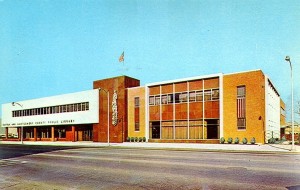 The library is once more outgrowing its downtown location, and has proposed an ambitious expansion plan in an effort to stay relevant and serve the community. Changes in technology – especially in book publishing – are creating a shift in how consumers patronize the library, and the usage of services has shifted to a lot more computer use, more online checkouts of e- and audiobooks, and more demand for meeting space, as opposed to shelf space for paper books. Studies have focused on cities like Fort Wayne, Indiana, where a new, expanded library has played a key role in revitalizing a stagnant downtown.
The library is once more outgrowing its downtown location, and has proposed an ambitious expansion plan in an effort to stay relevant and serve the community. Changes in technology – especially in book publishing – are creating a shift in how consumers patronize the library, and the usage of services has shifted to a lot more computer use, more online checkouts of e- and audiobooks, and more demand for meeting space, as opposed to shelf space for paper books. Studies have focused on cities like Fort Wayne, Indiana, where a new, expanded library has played a key role in revitalizing a stagnant downtown.
But the best part of the library remains the same – whatever book or written material you’re looking for, the library probably has it – and if they don’t, they have partnerships with a public libraries all over Ohio, and chances are, you’ll find it there. As has been the case for as long as I can remember, there’s no charge to have a book you’re looking for, transferred to your local branch if they don’t have a copy there. Loans for (and transfer of) materials from participating Ohio libraries are also free.
I got my first library card around age 6 or 7. Having lived in the area all my life, I’ve often taken the library for granted. But I’ve had friends who’ve moved out of the area to larger cities, who tell me their libraries don’t have near the selection Dayton’s library has.
What about you? Does your hometown have a great library? Do you use its service, or are you even aware of all your library offers? (I admit that if I were to try to list them, I’d probably miss a few.)
Historic photo via Dayton Metro Library www.daytonmetrolibrary.org
1960’s photo – unknown
